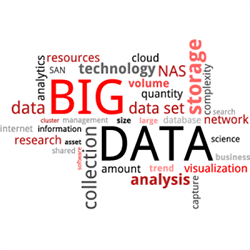 OK, let’s get the “big data thing” out of the way first. Healthcare data is already pretty big — and getting bigger all the time. The rise of personal health information, collected from electronic devices, coupled with increasingly detailed data from electronic health records maintained by health providers, has led to a universe of health-related data that already feels overwhelming. But we’re just getting started! Innovations related to the human genome and microbiome promise to push the boundaries of scale and complexity considerably further. The amount of data will be practically infinite relative to our ability to comprehend it. The real challenge of big data lies in digesting what we already have.
OK, let’s get the “big data thing” out of the way first. Healthcare data is already pretty big — and getting bigger all the time. The rise of personal health information, collected from electronic devices, coupled with increasingly detailed data from electronic health records maintained by health providers, has led to a universe of health-related data that already feels overwhelming. But we’re just getting started! Innovations related to the human genome and microbiome promise to push the boundaries of scale and complexity considerably further. The amount of data will be practically infinite relative to our ability to comprehend it. The real challenge of big data lies in digesting what we already have.
For all the advances in technology, the human mind will continue to be an important limiting factor: we can only deal with three to seven things simultaneously. As a workforce, our analytical skills are not keeping up with demand. Consulting firm McKinsey projects that by 2018 there will be a shortage of 190,000 data scientists and 1.5 million analysts and managers. So where do we begin to even attack the data explosion problem? As with many daunting challenges, going back to basics is often a good start. Here are five approaches that provide a foundation for dealing with big data.
Summarization:
Boiling the ocean is an apt metaphor for the first important step in dealing with big data. Distilling data to the point where you can begin to see and understand patterns allows you to begin to comprehend it – at a human level. But where do you even start when you’re working with tera-, or even petabytes of data? A set of techniques referred to as Exploratory Data Analysis (EDA) represents an increasingly popular toolset. In her book “Doing Data Science” former Google data scientist Rachel Schutt explains why EDA is essential regardless of the scope and scale of the data involved.
Context:
Data typically only makes sense if it’s presented in a context that facilitates some type of comparison. For example, observing that a hospital’s average length of stay (ALOS) for the past 12 months is 3.3 days isn’t particularly helpful by itself. However, this nuanced version of the statement could provide important insights: The 12 month ALOS for patients diagnosed with CHF is 4.2 which represents an improvement of .2 days over the previous period; it also compares favorably with an expected ALOS of 4.5 for CHF patients based on a benchmark of top quartile peer hospitals.
Visualization:
Most people can’t stare at a big table of numbers and make sense of the information. However, the human mind is very good at interpreting pictures. Fortunately data can be communicated quite elegantly and concisely through visualization. It turns out that we are able to discern patterns in basic geometric shapes particularly well. That accounts for why the most effective data visualizations make extensive use of lines and bars: simple, yet intuitive. Stephen Few’s book “Show Me the Numbers” provides both a fascinating explanation of this phenomenon as well as helpful guidance on employing a variety of visualization techniques.
Statistical Rigor:
Without at least some quantitative discipline, it’s easier to draw incorrect conclusions than it is to make truly meaningful observations. Time honored statistical techniques help keep us both honest and reliable. You don’t necessarily need to employ advanced approaches, like logistic regression, to take advantage of statistics. Using basic tools such as means, medians, modes, standard deviations and percentiles can help you understand important characteristics such as central tendency and dispersion. Bringing in additional techniques like hypothesis testing further allows you to draw conclusions from data with confidence.
Storytelling:
The ultimate point of analysis is to tease some form of story out of a collection of numbers and categorical variables. So with apologies to Rod Stewart, while every datum may tell its own story, the observations you make from collections of data provide the full picture. The communication skills necessary to develop the narrative for telling these stories represent an important complement to the technical data disciplines. The ability to both crunch the data and tell the story will no doubt be a much sought after talent in the next generation of “big data capable” analysts.
Ready for a test drive of our healthcare analytics software?
- Practical Analysis: The Next Chapter - May 21, 2020
- Exploratory Data Analysis Part 2: Helping You Make Better Decisions - October 11, 2019
- Practical Analysis: Understanding Visualization Concepts - September 19, 2019


